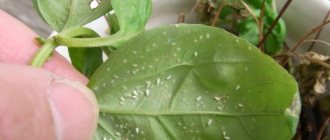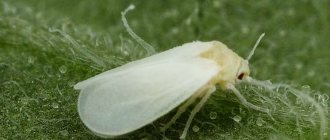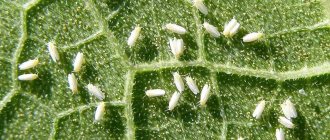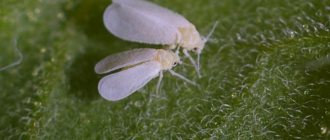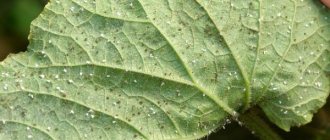How to recognize a whitefly?
Recognizing a whitefly is not at all difficult. This insect looks like a small butterfly, a few millimeters in size. The pest looks like a moth, has elongated white wings that resemble flower petals.
If you notice small butterflies flying near plants in your garden or greenhouse, you should definitely inspect the bushes in the area.
When exploring the area, pay attention to the following signs:
- is there a flock of moths when shaking the plants;
- the plants are healthy or their stems begin to dry out and the leaves lag behind in development;
- are there any white new growths (moth larvae) on the outside of the leaf?
- whether honeydew (liquid secreted by the whitefly during feeding) has appeared on the leaves of the plants.
Since the butterfly is very tiny in size, many older gardeners do not notice it at first. This insect reproduces quickly and produces up to 15 generations during the year, so the fight against the problem most often begins only when the summer resident notices huge swarms of pests when moving the plant.
The whitefly butterfly is considered a harmful insect
Harm from whiteflies
The white-winged borer harms more than 200 plant species. It likes to breed and feed in warm places with high humidity. The pest's favorite habitat is considered to be greenhouses, greenhouses and remote abandoned places in gardens, which receive the least attention.
The whitefly loves to feed on agricultural plants. You can expect it to appear in fields and gardens where potatoes, eggplants, cucumbers, legumes and pumpkins grow. The insect pays special attention to delicate plants, such as flowers of geraniums, orchids and violets.
The main harm from the appearance of whiteflies:
- Loss of harvest. By reducing the development of the plant, butterflies damage the plant, which negatively affects the timing of flowering, fruit formation, development and growth. The affected plant cannot bear fruit and is unusable.
- Death of the plant. Since the insect and its larvae feed on plant sap, it is impossible to overestimate the harm of the whitefly. The voracious offspring of the insect eats more plant sap than is necessary for its development, and the butterfly’s reproduction rate is so high that in the absence of control of the whitefly, it is possible to lose dozens, or even hundreds, of bushes.
- The occurrence of various diseases. Special attention should be paid to the fact that the butterfly is a carrier of various bacteria and viruses. The appearance of an insect can provoke the development of verticillium wilt, powdery mildew, cladosporiosis and bacterial rot.
- The appearance of sooty fungi. During their life, whitefly larvae produce a sweet liquid, which becomes an excellent place for mushrooms to settle. During development, the mycelium can cover the entire leaf, which leads to a decrease in photosynthesis.
More than 200 plant species are harmed by this moth
Why is it dangerous and how to identify whitefly?
Adults and larvae can completely destroy the plant. In addition to eating the bush, they can infect it with some diseases that they carry on their paws. The list of diseases includes the following:
- chlorosis;
- leaf deformation;
- phytopathogenic viruses.
From these diseases, many crops can not only grow poorly, but also die.
Insects feed on sap from plants, and can live both on bushes growing in a greenhouse and on those that develop in the ground. In addition, pests multiply quickly; in 3 weeks the larva already becomes a full-fledged individual. The period of development of an insect caterpillar is destructive for all plants, since the larva eats a lot.
Most often, whiteflies can be seen on eggplants, beans, cabbage and other vegetable plants.
After the life of the parasites, the leaves on the plants begin to turn black, and fungi form on them. In most cases, the plant cannot be saved from fungi. The bush stops its development and dies. The process is complicated by the fact that insects can feed on any crop, including indoor plants.
The whitefly in its shape resembles a small midge, but is distinguished by its large dimensions and pronounced wings. You can identify it in the following ways.
- Shaking the bush. A large cloud of insects should fly off it.
- According to the larvae, which are usually located on the inside of the leaf and have the shape of white capsules.
- It can also be identified by the condition of the plant, which after a certain time becomes covered with white liquid or black spots.
If you do not find out about its appearance in time, the culture will die. In addition, other plants will be at risk of damage, as the insect will move around in search of food.
Signs of plant damage by whitefly
It is very easy to spot a plant affected by the pest. Stopping receiving the required amount of nutrients, the plant begins to dry out. It weakens, the leaves begin to curl, and the stem withers. Leaves may also lose their usual color and turn light green or yellow. Larvae live on the underside of the leaf and spread the bacteria in their feces.
The appearance of sooty fungi on the plant further worsens the situation. A plant affected by butterflies becomes covered with a sticky dark coating, which prevents it from receiving enough sun and sprouting new shoots. All this prevents the plant from going through all stages of development, from youth to aging, and leads to loss of yield and early death.
How to get rid of whiteflies in the garden and greenhouse
How to get rid of whiteflies in the garden forever? It is important to start pest control on time. All methods of dealing with this miniature butterfly can be divided into several ways:
- physical destruction of larvae;
- the use of folk methods proven by more than one generation of gardeners;
- use of insecticides to control pests;
- creating climatic conditions in the garden bed that reduce insect activity;
- creating traps;
- introduction of natural enemies into the whitefly habitat.
The option of using insecticides to control pests deserves special consideration. Such control measures are becoming increasingly popular among summer residents every year due to their low time investment and high efficiency. Among the insecticides against whiteflies, one can highlight the use of Confidor Extra solution, applying Prestige, KS or Respect.Zhuka.Net at the roots when planting plants, or spraying the leaves against whiteflies and other sucking insects with Coragen, KS Expert Garden.
For active reproduction, the whitefly loves temperatures from 22⁰C with high humidity. If you are interested in the question of how to get rid of whiteflies in open ground, then you can reduce the number of offspring by frequently ventilating the greenhouse. Houseplants that are not afraid of the cold are best temporarily placed under an open window or on a balcony.
It is very easy to notice a plant affected by the pest
On strawberries
You should start fighting on the very first day that an individual of a harmful insect was noticed. Proven methods of controlling whiteflies on strawberries include:
- Construction of traps. Suitable at the initial stage of pest emergence. Around planting strawberries in the ground, colored cardboard is nailed onto wooden boards. The paper should be bright in color, because it is what will attract the insect. After installing the boards with paper, it is smeared with honey or other sticky product. Arriving into bright light, adult whiteflies stick to the honey and can no longer get out of the trap.
- Spraying with chemicals. If there are already too many insects and simpler methods of control do not help, gardeners begin spraying strawberry bushes with chemicals. Proven drugs in the fight against larvae and adult insects are “Aktellik”, “Aktara”, and “Fitoverm”. The dosage is set clearly according to the instructions. Many gardeners advise not to use the same product several times in a row to prevent butterflies from becoming accustomed to the drug. During the entire growing season of strawberries, up to 3 treatments can be carried out, but no later than a month before harvest. When the whitefly appears closer to the period of reddening of the fruits, it is better to use traditional methods of eliminating the problem.
- Folk methods of struggle. A popular and proven method is to prepare a garlic solution. To do this, use 100 g of garlic and 1 liter of water. The concentrate is infused for a week. To prepare the solution, use 10 ml of concentrate with the addition of 1 liter of clean water. Spraying with garlic solution is done every 7 days for 3-4 times.
On Victoria
Potatoes of the Victoria variety are often grown by summer residents both in greenhouses and in open ground. The variety is resistant to many diseases and produces a rich harvest, but it is impossible to completely insure the crop against the appearance of whiteflies. The use of chemicals is easier in open ground, since in a greenhouse, during the treatment with poisons, a person will have to breathe their fumes.
Biological products help get rid of whiteflies on Victoria
Biological products help get rid of whiteflies on Victoria in the spring. They are less harmful to humans compared to pesticides and do not accumulate in potato tubers.
The following biological products are used to combat whiteflies:
- "Aktofit". In case of severe whitefly infestation, use 4-5 ml of product per 1 liter of water. Many gardeners add liquid soap to the solution for better adhesion of the drug.
- "Boverin". A 1% solution is used; the drug contains fungal spores that kill harmful insects.
- "Verticillin". Suitable for use in a greenhouse, 250 ml of liquid is diluted in 5 liters of water.
On eggplants
To combat butterflies on eggplants, the above methods and chemicals are used. An effective folk method is a soap solution. Tar soap is grated and used in proportions with water 1:6. This soap solution can be used to spray plant leaves and stems, as well as wipe with a sponge. 1-2 applications of this solution are enough to completely eliminate the insect and its offspring.
On lemon
Many lovers of home flowers are attracted to growing a lemon tree. A bright and unusual plant delights the owner on gray winter days before the pest appears. Heat and high humidity indoors often contribute to the appearance of whiteflies in the summer.
To combat insects at home, several methods are used at once:
- treat the leaves with a soap solution, eliminating all butterflies and their larvae;
- transfer the plant for a short period to a balcony or other cool room;
- Sticky fly strips are hung around the lemon tree, to which the remaining butterflies stick.
Do you use folk signs in gardening?
If the number of parasites is small, the listed methods will work effectively. In other cases, it is more logical to immediately use chemicals.
“Fitoverm” and “Confidor” will help get rid of whiteflies on peppers
On the peppers
An additional way to eliminate small numbers of whiteflies is with a vacuum cleaner. Before shaking the bell pepper bush, turn on the vacuum cleaner at full power and point it towards the flying butterflies.
What remedy helps get rid of whiteflies? The drugs “Fitoverm” and “Confidor” will come to the rescue.
On the grapes
If butterflies appear before harvest, use only natural methods to combat them. To prevent the appearance of whiteflies next year after the grape harvest, use spraying with preparations such as “Skor” and “Fufanon”.
How to fight whitefly
If you follow all the instructions for caring for house plants, and the whitefly still appears, get ready for a long fight against it. So how to get rid of whiteflies on indoor flowers?
Most often, whiteflies settle on indoor plants such as orchids, begonias, fuchsias, gerberas, indoor pomegranates, gloxinias, geraniums, balsams and others. When growing tomato seedlings at home, the likelihood of this dangerous insect appearing in your apartment on all indoor flowers increases.
Fighting whitefly with folk remedies
Let's look at several ways to combat whiteflies on indoor plants without chemicals.
- Try to isolate the diseased plant from the rest. Ruthlessly cut off severely damaged parts of it, change the soil under the flowers where possible.
- Place the flower pot in a place with lower temperature and humidity, because at temperatures less than 10 degrees. Celsius, the life cycle of the whitefly is suspended, the adults die, and the larvae stop developing. Cold-resistant varieties of indoor plants can be placed under an open window or placed on the balcony for several days without harming them.
- A very effective method of dealing with flying moths is to collect them using a vacuum cleaner.
- It is also effective to place the pot with the affected flower under a cold shower in the bathroom. If you wash all the affected areas of the plant well, most of the parasites will be washed off and die.
- You can also spray your diseased flowers with a soap solution. To prepare it, 1 tbsp. dissolve finely grated laundry soap in 6 liters. warm water. Try not to let the soap solution get into the soil.
- Garlic infusion also destroys clusters of parasites. 3 cloves are crushed and poured into 1 liter of water. This mixture stands in a dark place for 24 hours. After this, the liquid is filtered and sprayed on the diseased plant.
- You can also remove whiteflies from indoor plants using shag or strong cigarettes. One pack per liter of hot water is enough. Let the solution brew in a dark place for 5 days, strain and spray the affected indoor plants.
- Another way to treat an infected plant is with dichlorvos. The pot with the plant is placed in a spacious plastic bag. A piece of cotton wool heavily treated with dichlorvos is also placed there. The bag is tied tightly and placed on a balcony or in a non-residential premises for 4-5 hours. After this, the flower pot is removed from the bag, washed in the bathroom, dried and put back in place under the supervision of the florist.
- To combat whiteflies, some amateur gardeners use ordinary fumigators against mosquitoes and midges. If you want to use this method, then close all windows and doors, turn on the fumigator closer to the diseased plant and leave. People and animals are not allowed to be in this room while the fumigator is operating - there is a risk of poisoning.
This may be interesting: Mealybug - how to deal with a dangerous pest?
All of the above methods for combating whiteflies are traditional. You must understand that you will not get rid of such a numerous pest as whitefly in one go. With a single treatment, only adult individuals die, while larvae in cocoons and eggs in protective shells often remain alive. Therefore, it is necessary to treat home flowers several times, with breaks of 5-7 days until the parasite is completely destroyed. Don't worry - folk remedies do not harm the plant.
Glue traps and tapes
To combat whiteflies, you can also use sticky traps. These are small cardboard or plastic plates, on which a layer of special entomological glue that does not dry in air is applied on both sides. It is non-toxic, odorless and colorless. Traps should be installed above or close to the flower pot. The traps themselves are brightly colored yellow. It is believed that this color attracts whiteflies; they flock to it from all sides and stick to the adhesive surface at the slightest touch.
Whitefly trap
If desired, you can make a whitefly trap with your own hands. Paint a piece of thick cardboard or plywood bright yellow and apply Vaseline or castor oil to the dried surface. You can install your invention directly in a pot using a holder or on a windowsill near a diseased plant.
Sticky fly tapes also work similar to sticky traps. They are also hung over flower pots affected by whiteflies or other flying midges.
Chemical control agents
How to destroy whiteflies on indoor plants if all folk remedies have been tried, but the whitefly continues to fly over the flowers? The time has come to use more powerful, chemical means of protection against whiteflies on indoor plants. The following drugs for controlling whiteflies are believed to be the most effective:
- Aktara. This is a systemic drug. It has a long period of effect on insects (from 3 to 5 weeks of protection). According to the instructions, you can water the diseased plant at the root with this drug and you can spray it. Aktara's destructive substance (thiamethoxam) enters the flower sap through the pores and roots of the plant, which both adults and larvae feed on. We recommend watering the affected plant with a strong solution of this drug, stronger than what is written on the package. The plant will not be harmed, and the entire colony of parasites will die almost 100% within 7-10 days. In case of very severe damage to indoor flowers by whitefly, it is necessary to repeat the treatment with Aktara a couple more times with breaks a week in order to be guaranteed to get rid of the sucking parasite.
- Confidor. It is an insecticide of systemic and contact action. When you use it, insects begin to die right before your eyes. The main population dies after a single watering at the root. But it is recommended to re-treat the infected plants after a week to consolidate the result. Other drugs with the same active ingredient (imidacloprid) are also used: KOMANDOR, APPLAUD, KOPFIDOR, MARATHON, GAUCHO.
- Akarin. It is an insectoacaricide of contact-intestinal action. It penetrates the parasite through food and direct contact. Almost all individuals parasitizing your plants die. It is necessary to thoroughly moisten all the leaves and stems of the plant by spraying, try to fill the entire colony of pests with this solution and get on the whitefly even when it flies up from the plant in a white cloud.
- Spark. This drug is available in different forms: water-soluble tablets, powder, liquid in ampoules or sticks. All this is used to water the plant affected by pests at the root. The active substance has a long period of plant protection. It remains in roots and tissues for up to 25 days and is thus a poison that kills the entire population of whiteflies in one treatment.
This may be interesting: Powdery mildew, Anthracnose and other spots and their treatment
In addition to those listed, the following are used to destroy whiteflies on indoor plants: Fitoverm, Actellik, Zeta, Fufanon, Alatar. (Read packages for instructions)
When treating whitefly-affected flowers, do not ignore your other indoor plants. We advise you to inspect them regularly, remove dried leaves and faded flowers, ventilate them more often and regularly wash the leaves and other parts of the plant with soapy water. To prevent the disease, you can even treat all flower plantings with some folk remedy. It is better to prevent a dangerous disease than to deal with multiplying parasites later.
Methods for controlling whiteflies on indoor plants
The opinion that whiteflies rarely appear on houseplants is erroneous. Humid weather and high temperatures contribute to the spread of the pest, even at home. Since the number of domestic plants is much smaller than in a greenhouse or open ground, getting rid of the pest at home is easier and faster.
On geranium
Many gardeners do not know how to get rid of whiteflies at home. If you notice a whitefly on your home geranium, do not rush to throw away the plant. In this case, we advise you to treat all domestic plants that were near the geranium.
Lemon leaves are treated with soapy water
Very often, a purchased plant is brought home with pest larvae. Many gardeners use chemical preparations - "Akrat" and "Intavir". The preparations can be used both for treating the soil and for spraying the stem and leaves of the plant. It is better to carry out the treatment indoors so that flying insects do not scatter throughout all the rooms.
On fuchsias
Whitefly loves home fuchsia very much. Sometimes it is very difficult to eliminate an insect, so several methods are immediately used to combat butterflies. How to get rid of whiteflies at home? To begin with, yellow paper coated with Vaseline is hung around the plant to eliminate some of the curious butterflies.
You can spray chemicals in the bathroom. Be sure to use a respirator, special clothing, goggles and gloves. Leave the treated plant overnight in a closed bathroom. The next morning, it is important to thoroughly clean the room. Do not use chemicals if you are pregnant or have pets. In such cases, it is better to think about fighting exclusively using folk methods.
On petunia
Some gardeners, in order to get rid of whiteflies in an apartment, place petunia bushes in a bag and spray dichlorvos inside. For a couple of hours, the tied bag is kept on the balcony with the windows open, after which the plant is put back in its original place. This treatment can be carried out before a family trip to nature or on a visit to prevent the drug from getting into the respiratory tract of family members.
Whitefly loves domestic fuchsia
On royal pelargonium
Before getting rid of whiteflies, the plants are carefully inspected. If you find pests, quickly isolate the infected plant from other flowers. Royal pelargonium is a special favorite for whiteflies. To combat butterflies on this flower, it is effective to immediately use specialized preparations. Water the soil with Aktara at intervals of 7 days. The product will penetrate into the plant tissue and accumulate there. In the process of eating the plant, the larvae and the moths themselves will consume poison, which will cause their death.
On hibiscus
Whiteflies can appear on hibiscus even in winter. Most often, the pest appears after purchasing a new plant in greenhouses. Many gardeners are interested in how to get rid of whiteflies without chemicals. To do this, you need to know: as long as the plant lives in a cool room, the larvae will not hatch, and by creating favorable conditions for their life, expect the appearance of white midges. The above methods for controlling whiteflies on geraniums and pelargoniums will also help control pests on hibiscus.
On an orchid
You can also get rid of whiteflies using folk remedies. When whiteflies appear, treat the orchid with a soapy solution. At the next stage, water the soil with Actellik. Prepare the solution according to the instructions. After a week, spray with the solution.
The orchid should be treated against whiteflies with a soap solution.
Methods of pest control
There are many effective ways to completely get rid of dangerous midges in your garden. However, unfavorable weather conditions and infected planting material can cause the appearance of a pest.
Mechanical methods
The easiest way to remove insects is to pick them off the plants by hand or wash them with soapy water.
Plants can be cleaned of pests with a stream of water under strong pressure.
Glue traps made from a yellow plate with special glue are also used to catch whiteflies. An insect attracted by the yellow color sticks to the sticky surface and dies. The most effective use of traps is in closed ground, although they are often used in open ridges. 2 plates are enough for an area of 10 m2.
The whitefly flies towards the yellow color and immediately sticks to the trap
To protect plants from harmful midges, I use phytonets. For convenience, I install arcs over the beds, over which I stretch protective material. Phytogrids allow the air and light needed by plants to pass through well, but do not allow insects to enter. Growing vegetables in a net house reduces the use of chemicals.
Phytonets reliably protect plants from pests
Fumigators
You can get rid of harmful butterflies using fumigators. In greenhouses, electrofumigators (plate or liquid) are used, which destroy pests with toxic vapors within a radius of 20–30 m. The fumes are destructive for larvae and adults, but are not dangerous for eggs. Therefore, after 2-3 weeks the procedure should be repeated.
Liquid fumigators emit fumes that poison flying pests
People and pets should not be in the treated area to avoid poisoning.
It is more advisable to use spirals outdoors. The drug creates a protective cloud over an area of 20 m2, once in which the midges quickly die.
A spiral made of smoldering materials impregnated with insecticides clears an area of 20 square meters from flying insects
Biological methods
Garden plants suffering from whiteflies can be cleaned with the help of entomophages - ladybugs, lacewings, ground beetles. Beneficial insects will happily settle on daisies, marigolds, and marigolds planted near the beds.
The ladybug is a natural enemy of the whitefly, destroying larvae and adults
I can significantly reduce the whitefly population using biological products containing fungal spores, which, upon penetrating the insect’s body, release toxins, causing death. It is better to use the preparations in combination, treating the plants and the soil around them twice: 200 ml of Boverin + 200 ml of Metarizin\10 l or 150 ml of Bitoxibacillin + 100 ml of Lepidocide + 60 ml of Actofit\10 l.
Unlike chemical pesticides, bitoxybacillin does not contain toxins, and its active substances are protein crystals and spores of microbial culture
Video: getting rid of whiteflies
However, in case of a massive invasion of harmful midges, biological methods should be combined with chemicals in reduced doses.
Traditional methods
Many summer residents use folk remedies instead of chemicals to control pests. But with a large population of whiteflies, such methods are ineffective.
Herbal infusions
Yarrow (90 g) is placed in a jar and filled with water (1 l), left for 2 days. Then filter and spray the leaves on both sides. Two repeated treatments are carried out with a one-week break.
Yarrow is an excellent natural insecticide that kills harmful insects.
Dandelion (roots and leaves - 40 g each) is crushed, filled with water (1 l) and left in a dark place for 4 days. Then they filter and treat the plantings three times once a week.
Dry pyrethrum inflorescences (30 g) are infused in 100 g of alcohol for 12 hours. After straining, the infusion is mixed with water (1 liter) and treated three times with a break of 3 days.
An alcohol tincture is prepared from dried pyrethrum flowers to combat pests.
Garlic water
Garlic (150 g) is crushed, poured with water (1 l) and left for 5 days. After straining, add water (20 ml\10 l) and liquid soap. Carry out 3 sprayings, waiting a week between treatments.
To prepare an insecticidal solution, garlic is crushed and infused in water.
Soda solution with iodine
Soda ash (1 tablespoon) is stirred in warm water (3 l), iodine (12 drops) is added and 2-3 treatments are carried out at intervals of a week.
Treatment with a solution of soda and iodine is a safe way to destroy parasites
Video: fighting whiteflies in a greenhouse
Chemical method
The chemical method allows you to quickly and effectively get rid of the pest. However, at the same time as parasites, insecticides can also destroy beneficial insects. In addition, the products can be consumed only 30 days after chemical treatment.
The use of chemicals allows you to quickly and effectively get rid of pests
When using chemicals, consider the developmental stages of the whitefly. Preparations Match and Admiral kill eggs and larvae of insects, but are not able to ensure the mortality of adult individuals. The use of Aktara, Actellik, Fufanon, Fitoverma, Bi 58 leads to the death of adults. Confidor, Monsoon, Inta-vir are effective at all stages of pest development. A one-week break should be observed between treatments.
Aktara, when sprayed, is quickly absorbed by the leaves and, destroying pests that feed on the underside of the leaf, retains a protective effect for up to 28 days
Table: effective insecticides against whiteflies
| A drug | Substance consumption | Number of treatments |
| Admiral | 1 ml\5 l | 2 |
| Fufanon | 1.5 ml\1 l | 1 |
| Aktara | 1.5 g\10 l | 3 |
| Inta-vir | 2 tab.\10 l | 2 |
| Aktellik | 1 ampoule\1 l | 3 |
| Confidor | 0.1 ml\1 l | 1 |
| Tanrek | 0.5 ml\1 l | 1 |
| Benzyl benzoate | 30 ml\1 l | 3 |
| Verticillin | 25 ml\1 l | 2 |
Chemicals have a long period of action (3–5 weeks) and are 90% responsible for the death of the population.
Intavir is an effective insecticide of enteric contact action, which leads to rapid paralysis of all organs of the pest insect, affecting its nervous system
How to prevent whiteflies?
An effective way to control insects is the biological method. It consists of placing direct enemies of small butterflies in a greenhouse or conservatory.
Encarsias are known enemies of whiteflies. Encarsias are small insects that lay eggs in whitefly larvae. Over the course of a month, a female encarsia is capable of housing about 100 of her young in whitefly larvae. Encarsia larvae feed on the body contents of whitefly larvae and obtain useful microelements from them. It is important to maintain the correct ambient temperature for encarsia propagation.
The macrolophus bug is also an enemy of the whitefly. The beneficial bug feeds on whiteflies, aphids and mites. During its life, one bug can destroy up to 2.5 thousand whitefly larvae and even more of its eggs.
